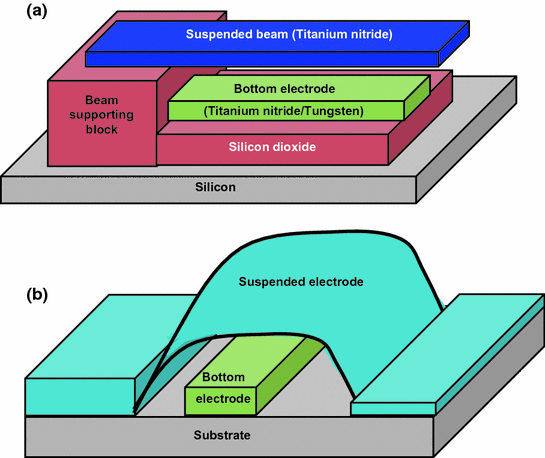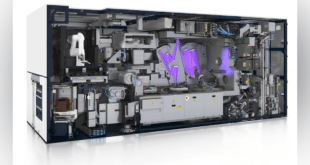MEMS is a word used for miniaturized devices that are based on Silicon technology or traditional precision engineering, chemical or mechanical. MEMS stands for MicroElectroMechanical Systems denoting man-made mechanical elements, sensors, actuators, and electronics that were produced using microfabrication technology and are integrated on a silicon substrate. The critical structural elements are on the micrometer length scale. These MEMS can be found in several commonly used electromechanical devices, such as accelerometers for airbags, sensors, microphones, LOC’s (lab-on-a-chip), and optical switches.
Nanofabrication technology has made significant progress more recently, and it is now possible to further scale MEMS down to nanoelectromechanical systems (NEMS). NEMS is a class of devices integrating electrical and mechanical functionality on the nanoscale ( that have critical structural elements at or below 100 nm.)
Manufacturing
NEMS typically integrate transistor-like nanoelectronics with mechanical actuators, pumps, or motors, and may thereby form physical, biological, and chemical sensors. Usually, NEMS rely on carbon-based materials, including diamond, carbon nanotubes and graphene.

NEMS can either be produced bottom-up (e.g. chemical self assembly methods, CVD methods, hot plate technique), top-down (e.g. metallic thin films or etched semiconductor layers that are produced with the help of etching, with scanning probe tools or with nanolithography methods) or via combined methods where molecules are integrated into a top-down framework. Carbon (graphene, carbon nanotubes) is a major material used in current NEMS.
Top-down approach: It uses conventional microfabrication techniques, such as the electron or optical beam lithography and thermal treatments, to build devices. Although it provides greater control over the resulting structures, it is limited by the resolution of the technique being used. In this approach, starting materials are relatively large structures such as silicon crystals. Generally, etched semiconductors layers or metallic thin films are used to fabricate NEMS devices such as nanorods, nanowires, and patterned nanostructures.
In some cases, large materials are crushed to the nanometer scale to increase the surface area to volume ratio, which ultimately enhances the reactivity of nanomaterials. The manufacturing process of carbon nanotubes using graphite in an arc oven is a perfect example top-down approach.
Bottom-up approach: It uses the chemical characteristics of molecules to organize or assemble them in the desired conformation. These approaches rely on the concepts of molecular recognition (specific interaction between two or more molecules) or molecular self-assembly (without external direction). While it provides limited control over the fabrication process, one can build much smaller structures without wasting a lot of material as compared to top-down approaches.
The bottom-up approach can also be found in nature. For example, biological systems exploit chemical forces to produce cell structures required for life. Researchers try to imitate this behavior of nature to create clusters of certain atoms that can self-assemble into some useful structures. One good example of such approaches is the manufacturing of carbon nanotubes using a metal-catalyzed polymerization technique.
Materials Used For Making NEMS
1. Polydimethylsiloxane
Polydimethylsiloxane is the most used silicon-based organic polymer. This silicone elastomer is known for its unique properties. It is thermally stable, chemically inert, mechanically configurable, optically clear, and in general, non-toxic, inert, and non-flammable. Since it can form a tight seal with silicon, it can be integrated into NEMS, configuring both electrical and mechanical characteristics. The adhesive forces of polydimethylsiloxane better perform under varying humid environments and possess a lower coefficient of friction compared to silicon.
Polydimethylsiloxane’s low friction coefficient and hydrophobicity make it a perfect material to be incorporated within NEMS research. It is also gaining attention in NEMS technology due to its time-efficient and inexpensive manufacturing. Studies show that the degradation rate of polydimethylsiloxane in light, heat, and radiation can be slowed with appropriate packaging and good aging stability
2. Micro and Nano Electromechanical Systems based on Gallium Nitride
MEMS successes are today based on top-down microfabrication and mostly silicon material. NEMS miniaturized mechanical structures offer promising routes for increasing devices sensistivity. However, many sensors markets in industry, exploration, and defense cannot use current MEMS/NEMS technologies because or performance degradation in harsh environments: high temperatures, high vibrations/accelerations, radiations, or corrosive media. In this context, NEMSGAN proposal aims at investigating the use of novel III-N materials and demonstrate the first nitride NEMS integrated inertial sensors.
These devices would withstand harsh environments in particular temperatures from 500K to 800K due to epitaxial nitrides robustness and specific refractory technologies developped for the transducers. Nitride NEMS will also take advantage of novel piezo-response phenomena for improved transducers response. They will combine nanostructures to micro-sized moving parts for optimizing the signal-to-noise ratio, having low power consumption and a high measuring bandwidth.
3. Carbon-based materials
Carbon allotropes, specifically graphene and carbon nanotube, are widely used in NEMS technology. Their characteristics directly meet the requirement of NEMS. For example, the semiconductor and metallic conductivities of carbon allotropes enable them to operate as transistors. In addition to the mechanical advantages of carbon allotropes, the electrical properties of graphene and carbon nanotubes allow them to be be used in several components of NEMS. The physical strength of graphene and carbon nanotubes fulfill higher stress demands. Thus, they are majorly used in NEMS technological development. While Graphene NEMS can operate as mass and force sensors, the carbon nanotubes NEMS have been widely utilized in nanomotors (that generate forces on the order of piconewtons), switches, and high-frequency oscillators.

3. Biological machines

Biological machines, such as myosin (handles muscle contraction), are the most complex macromolecular machines found within cells, typically in the form of multi-protein complexes. Some of them are responsible for energy production and some for gene expression. They might play a crucial role in nanomedicine. For instance, they could be used to detect and destroy tumor cells.
Molecular nanotechnology is an emerging field of nanotech that explores the possibility of engineering biological machines, which could rearrange matter at an atomic scale. BioNEMS includes biological and synthetic structural elements (of nanoscale size) for biomedical /robotic applications. Nanorobots, for example, can be injected into the body to identify and repair infections. While the proposed elements of BioNEMS, such as nanorobots and molecular assemblers, are far beyond current capabilities, several studies have yielded promising results for future applications.
3D printing NEMS
Researchers from the Polytechnic University of Turin and the Hebrew University of Jerusalem have used 3D printing technology to enable a new level of performance in nano-electromechanical systems (NEMS).
The production of conventional semiconductor-based NEMS usually involves a highly complex, multi-step, and costly fabrication process. While alternative methods such as screen printing, hot embossing, micro-injection molding, and even 3D printing have been trialed, they’re usually limited to the micro range (MEMS) and deliver relatively low-quality factors.
Looking at high-performance mass and force detection, specifically, the lower limits of sensitivity in these types of sensors are determined by two factors: a tiny resonator mass and a high-quality factor ‘Q’. The small mass allows for small perturbations to induce large resonance frequencies, while the high-quality factor Q means energy is retained for longer in the resonance mode, dampening the effects of smaller frequency fluctuations that would otherwise hide the true values of the larger perturbations. All in all, these two factors make for more precise sensors.
Unfortunately, achieving low masses and high Q in nano-scale sensing devices has historically required expensive and highly complex manufacturing approaches, which often also result in low fabrication yields. To challenge this, the research team employed the use of a Nanoscribe Photonic Professional GT 3D printer and a specially developed liquid ink made of metal salts.
Here, the joint research team leverages two-photon polymerization, a very precise form of SLA, to 3D print rigid NEMS resonators with performances comparable to those of silicon-based ones. By providing a viable, lower-cost alternative to semiconducting resonators, the work is expected to pave a new route to applications such as highly sensitive mass and force sensors.
After printing the NEMS resonator structures with the ink, the team heated the samples in a tube furnace for several hours to remove the organic content and increase the density of the metal precursors. This resulted in a set of rigid ceramic structures with high Young’s modulus and low damping characteristics.
The team reported that their 3D printed NEMS resonators delivered quality factors of up to 15,000 and tiny mass sensitivities of 450zg, which are indeed in line with the performances of conventional silicon-based NEMS resonators.
Further details of the study can be found in the paper titled ‘Reaching silicon-based NEMS performances with 3D printed nanomechanical resonators’.
References and resources also include:
https://www.azonano.com/article.aspx?ArticleID=2465
https://www.nanowerk.com/spotlight/spotid=51617.php
 International Defense Security & Technology Your trusted Source for News, Research and Analysis
International Defense Security & Technology Your trusted Source for News, Research and Analysis
